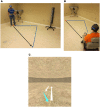Age differences in virtual environment and real world path integration
- PMID: 23055969
- PMCID: PMC3457005
- DOI: 10.3389/fnagi.2012.00026
Age differences in virtual environment and real world path integration
Abstract
Accurate path integration (PI) requires the integration of visual, proprioceptive, and vestibular self-motion cues and age effects associated with alterations in processing information from these systems may contribute to declines in PI abilities. The present study investigated age-related differences in PI in conditions that varied as a function of available sources of sensory information. Twenty-two healthy, young (23.8 ± 3.0 years) and 16 older (70.1 ± 6.4 years) adults participated in distance reproduction and triangle completion tasks (TCTs) performed in a virtual environment (VE) and two "real world" conditions: guided walking and wheelchair propulsion. For walking and wheelchair propulsion conditions, participants wore a blindfold and wore noise-blocking headphones and were guided through the workspace by the experimenter. For the VE condition, participants viewed self-motion information on a computer monitor and used a joystick to navigate through the environment. For TCTs, older compared to younger individuals showed greater errors in rotation estimations performed in the wheelchair condition, and for rotation and distance estimations in the VE condition. Distance reproduction tasks (DRTs), in contrast, did not show any age effects. These findings demonstrate that age differences in PI vary as a function of the available sources of information and by the complexity of outbound pathway.
Keywords: Alzheimer's disease; aging; hippocampus; navigation; path integration; spatial memory.
Figures



References
-
- Adamo D. E., Alexander N. B., Brown S. H. (2009). The influence of age and physical activity on upper limb proprioceptive ability. J. Aging Phys. Act. 17, 272–293 - PubMed
-
- Adamo D. E., Martin B. J., Brown S. H. (2007). Age-related differences in upper limb proprioceptive acuity. Percept. Mot. Skills 104, 1297–1309 - PubMed
-
- Allen G. L., Kirasic K. C., Rashotte M. A., Haun D. B. (2004). Aging and path integration skill: kinesthetic and vestibular contributions to wayfinding. Percept. Psychophys. 66, 170–179 - PubMed
-
- Atchley P., Andersen G. J., Wuestefeld A. P. (1998). Cooperativity, priming, and 3-D surface detection from optic flow. Percept. Psychophys. 60, 981–992 - PubMed
LinkOut - more resources
Full Text Sources
Research Materials
Miscellaneous

